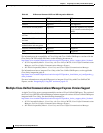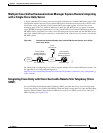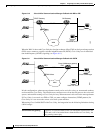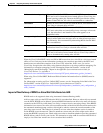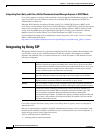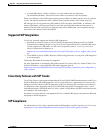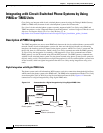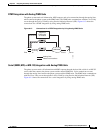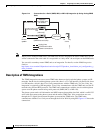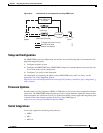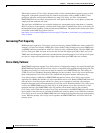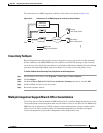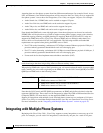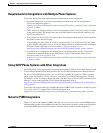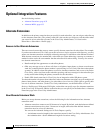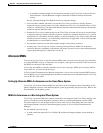
6-26
Design Guide for Cisco Unity Release 5.x
OL-14619-01
Chapter 6 Integrating Cisco Unity with the Phone System
Integrating with Circuit-Switched Phone Systems by Using PIMG or TIMG Units
Figure 6-14 Connections for a Serial (SMDI, MCI, or MD-110) Integration by Using Analog PIMG
Units
Note When you use multiple PIMG units, one PIMG unit must be designated the master PIMG unit, which
will be connected to the serial cable. It is not possible to “daisy chain” the serial ports on the PIMG units.
You can add a secondary master PIMG unit to an integration. For details, see the PIMG Integration
Guide at
http://www.cisco.com/en/US/products/sw/voicesw/ps2237/products_installation_and_configuration_g
uides_list.html.
Description of TIMG Integrations
The TIMG integration uses one or more TIMG units between circuit-switched phone systems and IP
networks. On the circuit-switched phone system side, there is a T1-CAS interface. On the IP side, there
is a SIP interface, which is how Cisco
Unity communicates with the TIMG unit. To Cisco Unity, the
integration is essentially a SIP integration. Cisco
Unity communicates with the TIMG unit over the IP
network using SIP and RTP protocols. The TIMG unit communicates with the circuit-switched phone
system over the phone network using serial protocols (SMDI, MCI, or MD-110).
The phone system sends call information and MWI requests through the data link, which is an RS-232
serial cable that connects the phone system and the master TIMG unit. Voice connections are sent
through the T1 digital lines between the phone system and the TIMG units. The TIMG units
communicate with the Cisco
Unity server through the LAN or WAN by using SIP. Figure 6-15 shows the
connections.
Analog lines
RS-232 serial cable
Network connections
Cisco Unity
server
153567
LAN/WAN
Master PIMG unit
(SMDI data and calls)
Additional
slave
PIMG units
as needed
Slave PIMG unit
(calls only)
Phone
system



